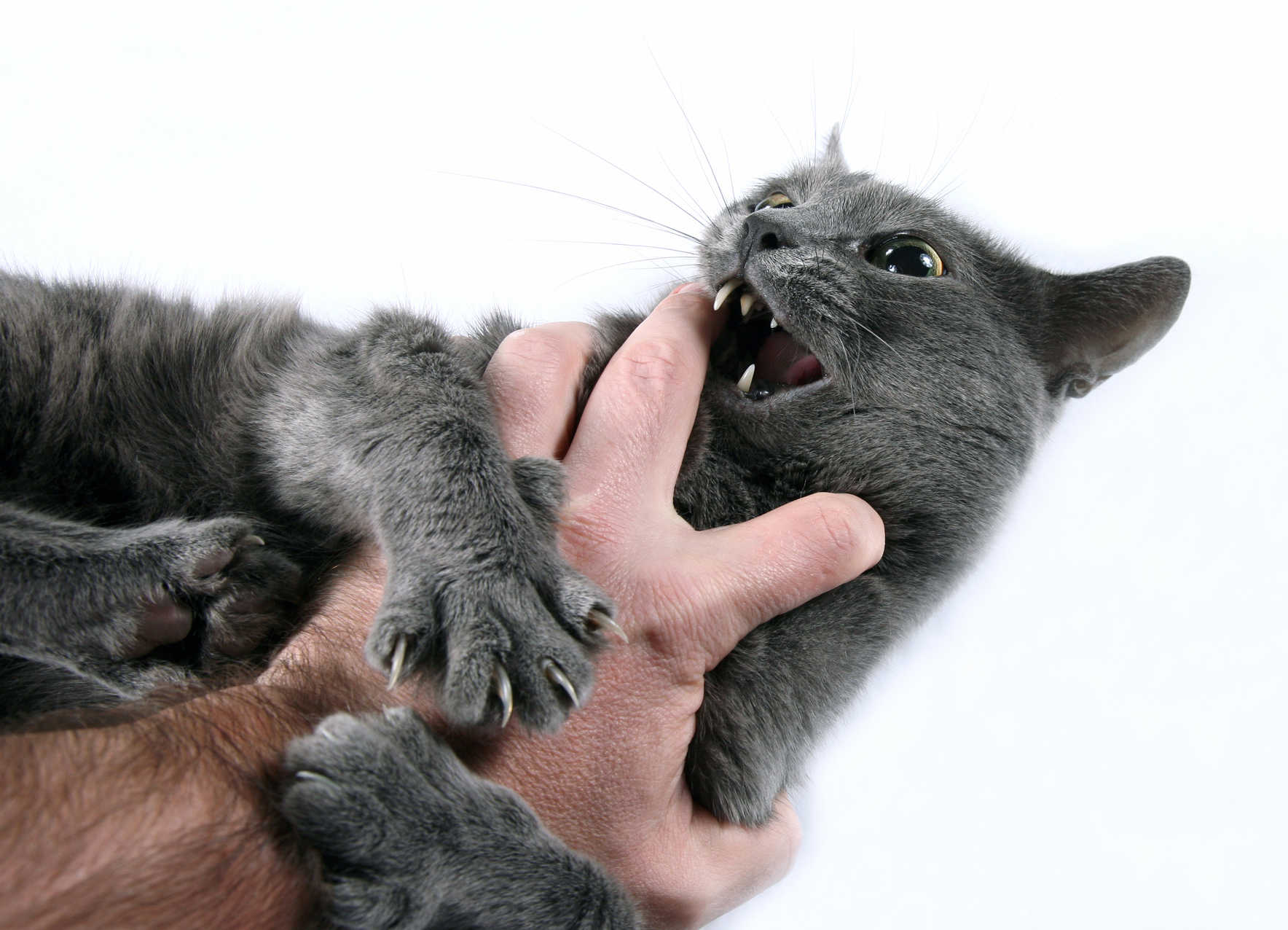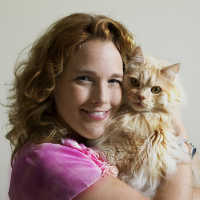You and your pet are enjoying an excellent cuddling session on the couch. You’re petting their back. Suddenly, they turn and bite your hand. It’s painful and unexpected! Luckily, there is an explanation. An interview with Dr. Cutler explains. Dr. Janet Cutler is a Certified Cat Behaviorist at Cat-World.com. She holds a Ph.D. in animal behavior and is a Certified Applied Animal Behaviorist (CAAB*).
Q: Why does my cat bite me?
Dr. Janet Cutler: Many cats have a short time where they enjoy petting or physical attention or don’t like physical attention. They may bite if signs that they are uncomfortable are not noticed or ignored by the person petting them.
Q: How common is it for cats to bite?
Dr. Jane Cutler: This is a common problem in households with cats; one study looking at cats referred to an Animal Behavior Clinic found that 39.6% of aggression cases were petting-induced aggression.
Q: What affects how or when your cat bites you?
Dr. Jane Cutler: Some cats may bite gently or hard depending on their level of arousal, while other cats may only have one type of bite. This can depend on their personality, experience in previous encounters, and situations. Cats can also bite during play, natural behavior for them, which can be gentle or hard as well.
Q: What are the signs a cat is about to bite you?
Dr. Jane Cutler: Cats often give subtle signs that they no longer enjoy a petting session and could bite. These include twitching tail, becoming tense or fidgeting, flattening their ears, and leaning away. This can also progress to showing their teeth or hissing.
Q: What do I do if my cat has bitten me after being petted?
Dr. Jane Cutler: Do not punish your cat for biting you. That can increase their stress or arousal, potentially leading to more aggression or damaging their relationship with you. This could also change their behavior in future petting sessions by showing fewer signs they are uncomfortable or biting sooner.
Q: How do I stop a cat from biting you after being petted?
Dr. Jane Cutler: The best way to stop your cat from biting during petting sessions is to watch their behavior carefully and stop petting before they bite. If they show any signs of discomfort (twitching tail, ears pulled back, tenseness, etc.), stop immediately. It’s also a good idea to pet for a short time, then stop and see what your cat does. If they walk away, they’ve had enough of that petting session. If they come back in for more petting, you know that they’d like more.
If your cat does not like being petted or does bite during short petting sessions, you can try associating treats with very short petting sessions. After a short petting session, you can also do something they enjoy, such as treats, catnip, or play with a toy.
Why do cats bite their owners or other pets?
It’s never a pleasant moment for your cat to bite you. It hurts—and it can even break the skin, causing you to bleed.
Cats bite to communicate with you and others, but there are a few things they may be saying.
- Petting: As stated above, petting-induced aggression is a common cause of cat bites. When petting a cat, especially in a sensitive area, they may become overwhelmed. Though cats communicate in other body language, sometimes it’s hard for us to understand. A cat will bite you to communicate they don’t want to be pet anymore.
- Playing: Cats bite during play to express their natural hunting instinct. As kittens, felines wrestle and play with others to learn mimic hunting behaviors. This translates into adulthood, where cats are used to rough, hunting play, which can include bites.
- Aggressive: The most common bite reasons are petting or playing, but some cats can bite out of aggression. Play nips cause little to no damage, whereas aggressive biting can. It can be dangerous, as cat bites can become infected. To recognize aggressive biting, look for other aggressive body language such as hissing, spitting, or a defensive, arched position.
My cat just bit me—is he playing or just being aggressive? How to tell and stop it!
We’ve already established that cats will bite to play or communicate with you. Playing generally is a lighter bite. But communication biting from aggression is usually hard, which can lead to deep bites.
Petting-induced aggression is sometimes referred to as “love bites.” But this isn’t reflective of the actual reasoning for the biting. Cats’ most sensitive areas include the base of the tail, the whiskers, and the stomach. Those contain more nerves than others, which can have increased sensation when pet there. It can feel overwhelming, leading to the biting behavior.
When you are part of a cat’s herd, social grooming happens. It means you are accepted as part of your cat’s pack. Has your cat ever started licking your hand or hair? As the grooming behavior becomes more intense, it can progress from licking to a little bit of teeth. This is the cat communicating they aren’t done grooming you.
Getting to actual aggression in cats, the signs should be obvious, but it’s hard to recognize during the situation. There are three types of aggressive behavior in cats: fear aggression, redirected aggression, and pain-induced aggression.
- Fear Aggression: This occurs when a cat encounters unfamiliar stimuli or is exposed to a previous negative experience. This is demonstrated with flat ears against heads, hissing, baring their teeth, fur standing on end, etc. It would help if you tried to identify and avoid situations that produce a fear response. When a cat is fear-aggressive, don’t try to console them, as it may be confused with aggressive behavior. Give them space.
- Redirected Aggression: This occurs when a cat is excited by something but cannot respond; they redirect their aggression toward a human. A common occurrence is seeing something outside a window but not being able to react to it. The best way to prevent this is to remove or avoid the stimuli.
- Pain-Induced Aggression: Cats in pain could act aggressively to avoid touch, movement, or other things that might worsen the pain. This pain can be managed by refraining from touching painful parts of the body and working with a veterinarian to establish a plan.
Is there something wrong with your cat?
It may be frightening or worrying for your cat to bite you or another animal. This doesn’t necessarily mean there is something wrong with your cat. There are many reasons for a cat to bite. It’s their version of communication.
We can determine the reason for biting by looking at its circumstances. Were you petting them? It was likely petting-induced aggression or pain-induced aggression. Is something new going on? It was likely fear aggression or redirected aggression.
If you have concerns regarding fear aggression or pain-induced aggression, contact your veterinarian for a check-up.
Which personality is your cat? Top cat personalities
In England, a study conducted by Dr. Lauren Finka reveals five personality types in cats. These develop due to “a complex interaction between each cat’s genetics and their experiences during development and adulthood.”
- Human: The human cat is happy to share their home, life, and personal space with humans. These are less likely to act aggressively with humans due to positive experiences during development and adulthood. These cats can still act aggressively due to pain or redirect aggression.
- Hunter: The hunter cat is the most feral, interacting with cat toys and showing signs of an expert hunter. As mentioned earlier, during play, cats may exhibit biting to showcase instinctive hunting behaviors. These cat types are more likely to engage in those behaviors but aren’t immune to other types.
- Cat: The cat’s cat is more willing to play with and groom its furry sibling, rubbing and touching noses together. These cats can be more likely to engage in play aggression due to their close relationship with siblings. Cats know biting is a natural play behavior, but they still communicate if the biting is getting out of hand.
- Cantankerous: This cat is more easily frustrated and can be less tolerant to handling due to sensitivity to touch and environment. These cats would be more likely to engage in petting-induced aggression, redirected aggression, and fear aggression. These cats like routine in their environment, and one change can cause significant distress. Additionally, be extra careful when engaging in rough petting sessions.
- Inquisitive: These are keen investigators, sniffing around anything unfamiliar. These cats are more likely to engage in fear aggression or redirected aggression due to their curious personality. When something changes, these are the first to check it out, leading to aggressive behaviors.
While your cat’s genetics and upbringing affect their adult personality, certain cat types aren’t immune to aggressive behaviors. Each circumstance is unique, just like your furry friend.
Get to know your cat’s likes and dislikes
We’ve established cats are unique creatures. While we can provide general advice regarding cats, how applicable depends on your cat’s likes and dislikes. It’s essential to get to know your cat’s personal likes and dislikes to understand what works best for your cat.
In general, here are things where your cat may have preferences:
- Litter Box: While most cat owners prefer a covered litter box to contain the mess and smell, cats usually prefer an open litter box. It makes them feel safe due to seeing all around them. Cats can also prefer the type of litter. Some like clay or wooden pellets, while others like the clumping litter. They can be picky even to the amount of dust coming out of the litter. If you’ve found a litter that works for your cat, it may be best not to change it. Cats have been known to go outside the litter box when their litter changes.
- Food: Humans tend to think of cat food in two camps: dry and wet. There are pros and cons to each, but it ultimately should depend on what’s best for your cat. If they are satisfied with one particular wet or dry food brand, you can’t switch them immediately. It’s best to change over a few days or even a few weeks by gradually adding the new food. Additionally, cats can have preferences over the smell, taste, temperature, and texture of food.
- Petting: Cats can prefer where they like to be petted. Some like belly rubs, but others will attack you for it. If your cat leans into the petting, they are enjoying it. If they lean away or try to get away, they don’t like being petted in the area.
- Closeness to Humans: Cats are picky about whom to be around and how close exactly. Lots can factor into this, but your cat will let you know. Some cats would prefer to be away from humans, even in the home. Others will cuddle directly onto your lap. There is a wide spectrum, but don’t force unwanted contact on your cat. It could drive them away even further.
- Play: Cats can prefer certain types of toys. It can be hard to know which toys are appropriate or loved best by your cat. The best method here is to have a variety and let your cat show you what they enjoy. Some like toys that mimic catching prey, while others like tossing their toys around.


